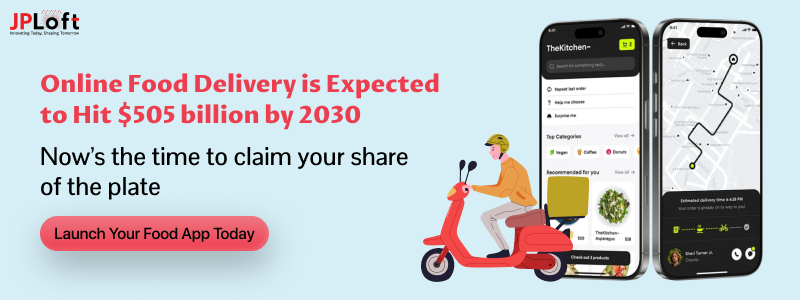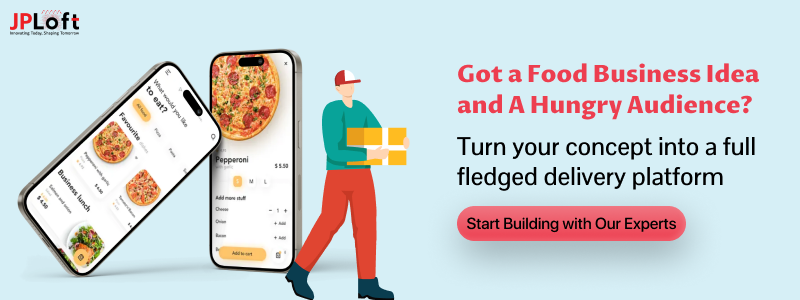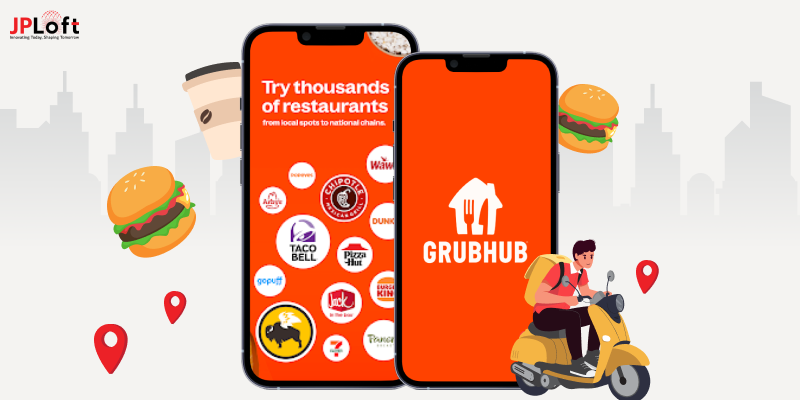In an era where convenience drives consumer behavior, the online food delivery industry has emerged as one of the fastest-growing sectors globally.
With busy lifestyles changing dining habits and the growing preference for on-demand services, more entrepreneurs are seizing the opportunity to capitalize on this flourishing market.
Starting an online food delivery business, however, is more than just connecting restaurants and hungry customers; it is about developing a seamless digital ecosystem for food accessibility.
From selecting the right business model and designing an intuitive app to managing logistics and customer expectations, every step plays a crucial role in shaping the success of your online food delivery business.
This blog is a guide to start an online food delivery business that walks you through the essential stages of launching your food delivery venture, key factors to consider, and how to navigate challenges to establish a sustainable and profitable business in today’s competitive landscape.
Key Takeaways:
The global online food delivery market is projected to reach USD 1.4 trillion by 2025, with a CAGR of 7.79%, making it a highly profitable sector.
Startups can choose from various business models like order-only, order & delivery, cloud kitchen, platform-as-a-service, hybrid, and subscription models.
Steps to start an online food delivery business include conducting market research, setting up a legal framework, developing an app, marketing, and scaling.
Food delivery app development varies between USD 8,000 to USD 250,000+, depending on features, platforms, and technology.
Profit can be generated through commissions, delivery fees, ads, subscriptions, surge pricing, and value-added services.
Partnering with JPLoft promises to give you the most outstanding start for your online food delivery business with our top-notch development experience.
What Is an Online Food Delivery Business?
An online food delivery business is a digital service platform that connects customers with local restaurants, cloud kitchens, or food providers via a website or mobile app to facilitate the ordering and delivery of meals directly to the customers’ locations, like home or workplace.
Customers browse restaurant menus, customize and place their food orders through the app or website, and then pay online or opt for cash on delivery.
Once an order is placed, the respective restaurant prepares the food, and either the restaurant itself or a dedicated delivery service managed by the platform or third parties delivers the meal to the customer.
Real-time order tracking, digital payments, customer reviews, and ratings are typically integrated to offer convenience, transparency, and a smooth user experience.
Is Starting a Food Delivery Business Profitable?
Yes, starting an online food delivery business can be highly profitable if planned and executed well. Launching an online food delivery business in 2025 is widely regarded as a profitable venture due to a blend of industry growth, consumer habits, and technology-driven opportunities.
Here’s an in-depth elaboration of the top reasons:
1. Extensive Market Growth
Revenue is expected to show an annual growth rate (CAGR 2025-2030) of 7.64%, resulting in a projected market volume of US$2.02tn by 2030. This expanding market means a steadily rising customer base and increasing transaction volumes, offering space for
2. Consumer Preference for Convenience
Modern lifestyles demand speed, variety, and ease, making food delivery platforms essential in urban and suburban settings. Customers prefer app-based ordering that frees them from cooking and dining out logistics, especially with busy work schedules and family responsibilities.
3. Higher Order Values and Upselling Potential
Average order values on food delivery apps are typically 32% higher than traditional dine-in, mainly from smart upselling features and suggested add-ons. AI-powered recommendation engines boost upselling conversion, increasing profitability per transaction.
4. Multiple Monetization Streams
Multiple monetization streams and profitable models include commissions (10%-30% per order), delivery fees, premium subscriptions, advertising, surge pricing, and value-added logistics services. A flexible mix allows platforms to adapt to changing market conditions and consumer behaviors, ensuring sustained income.
5. Technology Enables Scalability and Efficiency
Advances in app development, AI, real-time tracking, and predictive analytics enable food delivery businesses to scale quickly, optimize delivery routes, reduce errors, and improve customer experiences. Automation lowers costs and increases order throughput, making profitability achievable even when margins are tight.
6. Subscription and Loyalty Benefits
Subscription models (monthly or yearly) lock in recurring revenue while rewarding loyal customers with perks such as free delivery, exclusive discounts, or early access to promotions. These programs build customer retention, lowering acquisition costs and stabilizing revenue.
With strategic planning, efficient operations, and technology leverage, starting an online food delivery business in 2025 can be highly profitable, riding strong global market growth and evolving consumer trends.
Types of Food Delivery Business Models
The top players of the food delivery industry follow several common types of food delivery app business models. We've summarized some of the most well-liked and successful business models below to start an online food delivery business in 2025:
1] Order-Only Model
This model acts as an online marketplace that connects users with restaurants. The platform takes orders but does not handle delivery.
- Pros: Low operational costs. Easy to scale. Focus on tech and customer service.
- Cons: Less control over delivery quality. It depends on the restaurant's delivery systems.
- Revenue Sources: Commission from restaurants (10–15%), advertising fees, and subscription models for visibility.
- Examples: Grubhub (early model), Just Eat, FoodPanda
2] Order and Delivery Model
The platform manages both ordering and logistics (including delivery). This is the most common and scalable model.
- Pros: Better control over customer experience. Additional revenue via delivery fees. Wider market appeal.
- Cons: Requires investment in fleet/logistics. Operationally complex.
- Revenue Sources: Commission from restaurants (15–30%), delivery fees from users, surge pricing or peak-hour fees, and in-app advertising.
- Examples: Uber Eats, DoorDash
3] Fully Integrated Model (Cloud Kitchen or Virtual Restaurant)
The business owns everything, like the kitchen, menu, order system, and delivery. No third-party restaurants involved.
- Pros: Complete control over food quality and delivery. Higher profit margins. Efficient use of real estate (no dine-in space needed).
- Cons: High initial investment. Limited menu appeal if not diversified.
- Revenue Sources: Direct food sales, subscription plans, and bundle meal offers.
- Examples: Freshmenu, Domino’s, Pizza Hut
4] Platform-as-a-Service Model
This model offers a white-label food delivery platform to other restaurants or businesses that want to run their own branded delivery service.
- Pros: Recurring income through SaaS fees. No operational risk. Scalable to multiple clients.
- Cons: Less brand visibility. Limited revenue per client.
- Revenue Sources: Monthly subscription or setup fees and custom add-ons (e.g., analytics, marketing).
- Examples: GloriaFood, ChowNow
5] Hybrid Model
Combines two or more models. For example, a platform may offer its kitchen and also partner with third-party restaurants.
- Pros: Diversified income streams. Better control and scalability. Competitive edge with proprietary. Services.
- Cons: High complexity. Needs a strong backend and management.
- Revenue Sources: Commission, delivery charges, ad revenue, and direct sales from own kitchens.
6] Subscription-Based or Meal Plan Model
Users subscribe to weekly/monthly meal plans, often targeted toward specific diets like keto, vegan, or fitness meals.
- Pros: Predictable revenue. Strong brand loyalty. Better inventory and logistics planning.
- Cons: Limited flexibility for customers. Requires high customer retention.
- Revenue Sources: Meal subscriptions and Upsells (juices, snacks, upgrades)
- Examples: HelloFresh, Freshly
Understanding these models will guide you in building a sustainable, scalable food delivery app that fits your market environment and business goals. Each of these models offers unique opportunities and challenges in the growing food delivery market.
Let's now go through the easy steps to start an online food delivery business.
How to Start an Online Food Delivery Business?
Starting an online food delivery app business involves a systematic approach covering market research, business planning, technology development, and operational setup.
Below is a comprehensive step-by-step online food delivery business startup guide:
Step 1. Market Research and Understanding the Industry
Thoroughly research the food delivery market in your targeted area. Identify your potential customers, their preferences, and their pain points. Analyze competitors to discover their weaknesses and strengths, and users’ behavior to create an app with unique selling points.
Step 2. Choose Your Business Model
Decide and choose the operational model that aligns best with your business goals and standards. Each model has different cost, management, and scalability implications.
The most common business models are the order-only model, the order & delivery model, the cloud kitchen model, and the subscription-based or meal plan model.
Step 3. Create a Detailed Business Plan
Draft a business plan of how to start an online food delivery business, defining your goals, target market, and key performance indicators. Outline your marketing strategy, operational workflow, and financial projections, including startup costs, expected revenues, and ongoing expenses. Budget for technology development, marketing, staff, kitchen setup (if applicable), and delivery logistics
Step 4. Legal and Licensing Requirements
Register your business legally through appropriate business structures. Obtain essential food safety licenses and any local approvals, such as signage and shop establishment certificates. These ensure compliance with food safety, taxation, and operational laws.
Step 5. Develop Your Food Delivery App
This is the core of your business. Focus on the development of a user-friendly food delivery mobile app with essential features:
- Customer App: Easy registration/login, browse/search restaurants, menu listing, real-time order tracking, payment gateway integration, reviews & ratings, push notifications, loyalty rewards, and secure payment gateways (PayPal, Stripe).
- Restaurant App Dashboard: Menu management, order tracking, earnings dashboard, analytics reports, and inventory status.
- Delivery Driver App: Order notifications, navigation support with route optimization, earnings dashboard, status updates, and real-time tracking
- Admin Panel: Dashboard for managing users, orders, payments, and analytics.
Step 6. Choose a Scalable Tech Stack for App
Choose the right mobile app technology stack that supports scalability and cross-platform compatibility. Frameworks like Flutter or React Native allow simultaneous Android and iOS development, reducing costs and time.
Backend technologies such as Node.js, Django, or Ruby on Rails offer scalable and reliable performance. Cloud-based infrastructures like AWS or Google Cloud ensure scalability and reliability.
Step 7. Build a Minimum Viable Product (MVP)
Instead of launching a full-featured app, start with an MVP focusing on core functionalities to enter the market quickly and economically.
Gather user feedback to continually improve your app by adding features based on actual customer needs and business priorities.
Step 8. Establish Restaurant and Delivery Partnerships
Build a network of restaurant partners by pitching the advantages of joining your platform. For delivery, hire or outsource delivery personnel, ensuring reliability and timeliness.
Strong partnerships are critical for seamless food supply and customer satisfaction.
Step 9. Set Up Payment and Logistic Infrastructure
Integrate multiple payment gateways for customer convenience, supporting credit/debit cards, digital wallets, and UPI if relevant to your market.
Logistics management includes real-time order tracking, delivery scheduling, and route optimization for efficient operations.
Step 10. Marketing and Customer Acquisition
Launch marketing campaigns highlighting your unique strengths, such as fast delivery, variety, quality control, or exclusive offers.
Use digital marketing (social media, SEO, app store optimization) and offline strategies (partnerships, flyers) to build brand awareness. Early promotions and referral bonuses encourage user adoption.
Step 11. Go Live, Analyze, and Iterate
Launch a soft pilot to a smaller community to collect feedback and measure performance, tracking metrics like order volume, average delivery times, ratings, and customer retention. Use tools like Google Analytics or Firebase to monitor app performance.
Continuously refine your offerings, add new features, expand to more restaurants, and scale geographically as product-market fit becomes clear.
Step 12. Continuous Growth and Scaling
Once validated, expand into new regions, onboard additional restaurants and delivery partners, and consider adjacent services (like groceries or catering). Regularly monitor food delivery app trends to stay competitive and optimize operations and technology for efficiency.
By carefully following this process to launch an online food delivery business, you can conduct detailed market research, choose the right business model, develop a user-friendly app, secure legal licenses, and implement efficient operations.
Along with regular mobile app maintenance, you can successfully build a scalable and popular online food delivery app business in the current market. Next, we will go through the budget planning for starting the online food delivery business.
Cost to Launch a Food Delivery App or Website
The development cost of food delivery apps requires proper budgeting and a specialized development team to avoid any blunder pre- or post-launch. This cost can fall between $10,000 to $25,000.
The cost to launch a food delivery app or website in 2025 varies significantly depending on the features, app design complexity, number of supported platforms (iOS, Android, web), frequency of mobile app testing, and your choice of development partner.
Estimated Investment Ranges:
1. Basic MVP (lean, order-only, or marketplace)
-
- Costs: USD 8,000 to USD 20,000
- Timeline: 6 - 12 weeks
- Features: Cross-platform customer app (minimal features), simple restaurant portal, basic backend.
2. Standard (order + delivery, scalable)
-
- Costs: USD 25,000 to USD 70,000
- Timeline: 3 - 6 months
- Features: Cross-platform apps or native single-platform, delivery partner app, admin panel, 3rd-party integrations, basic analytics.
3. Advanced/Feature-Rich or Highly Customized App
-
- Costs: USD 80,000 to USD 250,000+
- Timeline: 6–12+ months
- Features: Native apps, robust backend, AI features, dynamic pricing, multi-tenant support, advanced analytics, higher QA.
Online Food Delivery Business Cost Breakdown Table:
|
Component |
What it includes |
Cost (USD) |
|
Product discovery & UX/UI design |
Research, wireframes, designs, prototypes |
$2,000 – $10,000 |
|
Customer mobile app (iOS + Android) |
Native (both) |
$20,000 – $80,000 |
|
Customer mobile app (cross-platform) |
Flutter/React Native (both) |
$12,000 – $40,000 |
|
Restaurant dashboard |
Menu, orders, earnings, reports |
$3,000 – $10,000 |
|
Delivery partner app |
Order queue, navigation, earnings |
$4,000 – $20,000 |
|
Backend & APIs |
Order engine, DB, auth, real-time sync |
$8,000 – $30,000 |
|
Admin panel |
Platform controls, analytics |
$2,000 – $8,000 |
|
QA & testing |
Manual + automated tests |
$1,500 – $8,000 |
|
Integrations |
Payments, maps, SMS, email, analytics |
$300 – $3,000 |
|
DevOps & hosting (1st year) |
Cloud servers, CDN, DB |
$500 – $5,000 |
|
Legal & compliance |
Business registration, food licenses, contracts |
$300 – $3,000 |
|
Marketing & launch |
Ads, promos, onboarding incentives |
$2,000 – $20,000 |
|
Delivery logistics setup |
Fleet onboarding, onboarding staff |
$1,000 – $20,000 (highly variable) |
|
Estimated Subtotal |
$8,000 – $250,000+ |
Additional Business Expenses (Beyond App Development)
- Hosting & CDN: $50 – $2,000+
- Third-party APIs (maps, SMS, emails): $50 – $1,000+
- Payment gateway fees: per-transaction (2–5% typical)
- Maintenance & development: $500 – $8,000+/month
- Customer support & ops: depends on scale (staff costs)
- Marketing: $500–$10,000+/month during growth stage
To optimize the budget, launch with core food delivery app features, then iterate and add functions as the user base of the app grows. Always factor in ongoing maintenance and scaling costs to keep your app secure, updated, and competitive. The next crucial step is to establish effective monetization strategies that will ensure your business remains profitable and sustainable.
Monetize Food Delivery Business with Simple Models
Monetizing a food delivery business effectively relies on simple yet proven revenue models that can create steady income while scaling.
Here are some common monetization strategies commonly used while creating a food delivery app:
► Commission Model
In this model, the app business charges restaurants a commission fee for every order placed through their app. Typically, this fee ranges between 10% and 30%, depending on your market position and the service provided.
► Delivery Fees
Charging customers a delivery fee for each order helps cover logistics costs. Delivery fees can be fixed or dynamically adjusted based on distance, demand, or time of day. This combination balances revenue streams while managing operational expenses.
► Subscription/Membership Plans
Offering subscription-based premium memberships to customers can generate recurring revenue. Subscribers get perks like free deliveries, exclusive discounts, or faster deliveries for a monthly or annual fee.
► Sponsored Listings and Advertising
Restaurants pay to get featured prominently on the app’s home page or search results, increasing visibility and order likelihood. You can also advertise third-party products with a fee, giving relevant offers from the brand wanting to reach your audience.
► Surge Pricing
During peak hours or high-demand periods, increase delivery fees or minimum order requirements. This dynamic pricing approach helps balance demand with delivery capacity and maximize revenue during busy times.
► Value-Added Services
Extensions such as catering orders, event food delivery, or grocery delivery using the same platform infrastructure create new revenue streams. Partnering with local providers or expanding vertically increases business resilience.
Combining commissions from restaurants, delivery fees from users, subscription plans, and advertising forms a simple yet versatile monetization framework.
The food delivery app monetization strategies should align with your business model and local market preferences to optimize income while maintaining good customer and partner relationships.
Along with benefits come the challenges of establishing an online food delivery business. So, next, we will cover a few of the pain points while establishing your own delivery business.
Common Challenges in Starting a Food Delivery Business
Start a food delivery business from scratch offers significant opportunities, but it also brings a range of challenges, such as technical, operational, and strategic.
Here are the most common food delivery app development challenges entrepreneurs and developers may face in 2025 while establishing an online food delivery business:
1. High Market Competition
Challenge: The market is highly saturated and has cut-throat competition. New entrants often compete with well-established giants with extensive customer bases.
Impact: New businesses struggle to gain visibility and customer trust.
Solution: Focus on niche markets like organic food, vegan meals, or hyperlocal delivery and provide a unique value proposition.
2. Technology Integration and App Reliability
Challenge: Building and maintaining a stable, user-friendly app and backend system is costly and requires hiring dedicated developers.
Impact: Bugs or crashes can result in lost orders and revenue, affecting user retention as well.
Solution: Choose reliable development partners or white-label platforms, or an ongoing mobile app maintenance services that provides updates.
3. Customer Acquisition and Retention
Challenge: With so many options and frequent promotions from competitors, acquiring and retaining loyal users is a challenge.
Impact: Profits shrink if retention is low.
Solution: Use referral programs, loyalty rewards, and personalized offers to retain users and encourage repeat orders
4. Restaurant Onboarding and Partnership Management
Challenge: Convincing restaurants to join your platform can be challenging, especially when they’re already on others.
Impact: A limited number of restaurants reduces customer choices.
Solution: Offer competitive commissions, transparent terms, and better exposure to attract vendors.
5. Scalability Issues
Challenge: Growing from one region to multiple cities involves operational, technical, and financial challenges.
Impact: Overextension can lead to service breakdown.
Solution: Scale gradually with a strong foundation and localized strategies.
6. Payment Failures and Fraud
Challenge: Payment gateway errors or fraudulent transactions can occur.
Impact: Financial losses and frustrated users.
Solution: Use secure, PCI-DSS compliant payment processors and enable fraud detection systems.
Managing these challenges proactively will boost your chances of building a resilient and successful online food delivery business in today’s highly competitive, tech-driven market.
The following section will explore how you can choose future trends to ensure that your app is able to withstand future feature demands for food delivery apps.
Future Trends in Online Food Delivery Industry
The future of the online food delivery industry is being transformed by rapid technological advances, particularly in artificial intelligence (AI), agentic AI, augmented reality (AR), and virtual reality (VR), making services smarter, faster, and hyper-personalized.
Here’s an in-depth look at the key trends:
A] AI-Powered Personalization and Recommendations
AI systems now analyze user preferences, order history, dietary restrictions, and even health data to offer tailored food suggestions. Hyper-personalization through intelligent suggestion leads to higher customer satisfaction, increased order value, and greater loyalty.
B] Autonomous Intelligent Agents—Agentic AI
Agentic AI observes, decides, and acts independently according to the requirements of the food delivery services. They dynamically manage reservations, optimize preparation/delivery in real time, coordinate inventory/supply chain management, and provide customer support.
C] Augmented Reality (AR) Customer Experiences
AR technology enables customers to preview dishes in highly realistic 3D before ordering, aiding discovery and decision-making. This immersive visualization increases users’ confidence, improves online menus, and lets restaurants creatively showcase meal presentation.
D] Virtual Reality (VR) Engagement
VR is used to create immersive restaurant experiences from home, virtual store tours, or interactive cooking classes. These applications can boost brand uniqueness and customer engagement, especially for premium or theme-based food ordering platforms.
E] AI-driven Logistics and Predictive Analytics
Hire an AI app development company to integrate advanced AI tools for optimizing everything from route planning to real-time geo-tracking and predictive demand forecasting. Predictive analytics also enables dynamic pricing and proactive inventory management based on weather, event trends, or social media sentiment.
F] Voice and Chatbot Ordering
Ordering by talking to smart assistants is becoming increasingly common. Future platforms will deploy multilingual, context-aware AI chatbots and voice commands across devices, enabling rapid, hands-free ordering and comprehensive customer support.
The convergence of AI, AR, VR, and automation is setting new standards for convenience, trust, and innovation in online food delivery. Companies that invest in building an AI app with these technologies will define the future of how users order and experience, from discovery to doorstep and beyond.
Why Choose JPLoft to Build Your Food Delivery App?
Selecting JPLoft, the best food delivery app development company, as your development partner ensures your food delivery app stands out in a competitive market. With over a decade of experience in app and web development, we specialize in creating scalable, user-friendly platforms that drive real results.
Whether you are launching a startup or expanding an established food chain, our team delivers end-to-end solutions, from UI/UX design and app development to integration, deployment, and post-launch support.
We offer custom features like real-time order tracking, smart recommendations, secure payments, and multi-vendor support.
At JPLoft, we don't just build apps, we build bases for successful businesses. Let us help you turn your food delivery idea into a revenue-generating platform that keeps users coming back.
Conclusion
Starting an online food delivery business offers tremendous opportunities in today’s fast-paced, convenience-driven world. By leveraging the right business model, technology, and partnerships, you can build a scalable and profitable venture. Success requires thorough market research, legal compliance, a seamless digital platform, reliable logistics, and an effective marketing strategy.
While challenges like competition, quality control, and operational efficiency exist, advances in technology are powerful enablers that can differentiate your business and enhance customer satisfaction. With strategic planning and execution, your online food delivery business can tap into the expanding demand and transform how people enjoy food conveniently at their doorstep. This thriving industry holds promising potential for innovators ready to meet evolving consumer needs.
FAQs
Start by researching your target market, understanding customer needs, and analyzing competitors. Then choose a suitable business model (e.g., order-only, delivery-managed, or cloud kitchen) and create a detailed business plan covering operations, marketing, and finances.
This depends on your resources and goals. The order-only model requires minimal investment and focuses on connecting customers and restaurants. The delivery-managed model gives you more control but needs logistics capabilities. Cloud kitchens offer full control over food and delivery but require a higher upfront investment.
Essential features include easy registration/login, restaurant browsing and search filters, real-time order tracking, secure payments, customer ratings/reviews, and separate dashboards for restaurants and delivery personnel to manage orders efficiently.
Use a mix of digital marketing (social media, influencer partnerships, referral programs). Early discounts and loyalty rewards help attract and retain customers. Focus on excellent customer service and fast delivery to build trust and repeat usage.
Start by partnering with local restaurants that complement your target market. Offer transparent commission structures and marketing support. For deliveries, hire or contract reliable drivers and train them on customer service and route optimization.













Share this blog